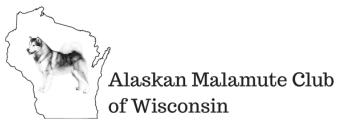This page contains information about the health issues related to the Alaskan Malamute.
Canine Health Foundation
The mission of the American Kennel Club Canine Health Foundation, Inc. (CHF) is to advance the health of all dogs and their owners by funding sound scientific research and supporting the dissemination of health information to prevent, treat, and cure canine disease. The Foundation has established a series of goals as well as a strategy for achieving these goals. Find out more here.
The AKC Canine Health Foundation has been awarded a third consecutive 4-star rating by Charity Navigator, America’s largest independent evaluator of Charities.
Tick-borne Illness
AMCW member Karin Fischer wrote a good article on tick-borne illnesses for one of our newsletters. While the experience she writes was personal to her, the facts are certainly worth sharing. It should be noted that these illnesses can happen to any breed, and are not specific to Malamutes. Click here to view the article.
Chondrodysplasia
CHD, also known as “dwarfism”, is unique to Alaskan Malamutes. The major clinical symptom is malformation of the long bones of the front legs. This can vary from a mild “bowlegged” appearance to severe distortion with the front legs being much shorter than the rear. It is an inherited syndrome, and the gene is a simple recessive one (like blue eyes in people). Dogs can carry the gene, but not have the syndrome. A “carrier” bred to another “carrier” will produce puppies who have CHD. Shortly after the condition was recognized, in the late 1960’s, the Alaskan Malamute Club of America set up a program to help breeders identify dogs carrying the gene in the hope of eliminating the “carriers” from the breeding pool, and, someday, eliminate the gene itself. Research is currently underway to identify the genetic marker and develop a DNA test to identify “carriers”. For further information, go to the Chondrodysplasia article at AMCA.
Hip Dysplasia
This malformation of the bones of the hip joint occurs in Malamutes and over 100 other breeds of dog. Although it is well known and documented, there is still much controversy about its mode of inheritance and the effect of environment on this crippling disease. Again, the severity of malformation can vary widely, from severe lameness in a young adult to subtle differences seen only in X-rays by a trained radiologist. Also, even the most careful breeders, who clear their stock by X-ray examination, can produce a dysplastic animal occasionally. The Orthopedic Foundation for Animals, Inc is the central clearing house for reading X-rays of several orthopedic problems in dogs, including Hip Dysplasia. They issue a serialized Certificate rating the conformation of the hip joint, and whether any evidence of Dysplasia is present.
Responsible, careful breeders will have their breeding stock X-rayed and cleared of Dysplasia by either the OFA or a certified veterinary radiologist. They will also guarantee the puppies against developing the problem. (However, since the pup is usually over a year old before any problems are noticed, giving up the dog is not an easy option. Dealing only with breeders who use only carefully selected dogs will lessen your chances of having to deal with the problem.)
Gastric Dilation/Vulvus
Otherwise known as “Bloat”, this illness strikes fear in the heart of many dog owners. Excess gas is produced, causing the stomach to distend (dilation), then the stomach twists on its axis (vulvus), trapping the contents. As more gas is produced, the swelling stomach presses on major arteries and veins, cutting off blood supply to itself and other organs, such as the spleen. As the blood flow is restricted, blood pressure can drop while the heart beats faster but weaker. Soon the dog goes into shock. All this takes place in a matter of hours, or even minutes. It is considered a medical emergency as soon as the stomach twists.
Malamutes, with their large, deep chests, are definitely susceptible to this disease. Here are some symptoms to watch for: your pet is trying to vomit, but nothing comes up; he seems uncomfortable lying down, but walks a little bit and tries to lie down again; when you feel his tummy, it seems extra full and tight; he looks like he swallowed a basketball. Your vet will forgive you for calling at 3:00 am if you notice these symptoms!!
Although much is known about what happens during all this, little is known about why, or what causes it. A few things the owner can do include: avoiding foods that make your dog “gassy”, feeding two or more smaller meals rather than one large one; not exercising your dog shortly before or after meals. For more information, please see Gastric Dilation/Vulvus, an article written by a vet.
Day Blindness & Other Eye Problems
Day Blindness (or Cone Degeneration) and Progressive Retinal Atrophy are inherited diseases which have occurred in a small number of Malamutes. Day Blindness is just that, difficulty seeing in bright light, including daylight. Affected puppies will seem clumsy outdoors, following their nose into obstacles, etc., yet be perfectly normal indoors. Diagnosis is confirmed by Electroretinograph. Affected dogs can lead otherwise normal lives; just keep them in dimmer lighting.
Where Cone Degeneration involves the cones in the eye, PRA involves the rods and the cones. It is not usually seen until middle age, and starts with problems seeing in the dark, as the rods fail. It can progress to the cones also, resulting in total blindness. Examination by Electroretinograph is the best way to diagnose this, also. Many breeders now have their dogs’ eyes examined by an Ophthalmologist annually and the results sent to the Canine Eye Registration Foundation (click for more info). This way other, more minor problems are caught before they become significant to the breed.


